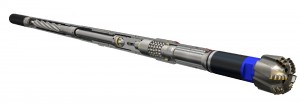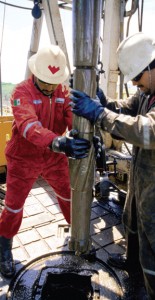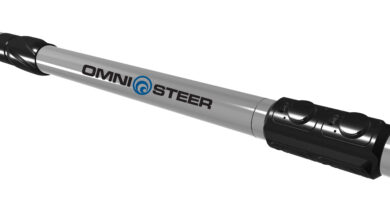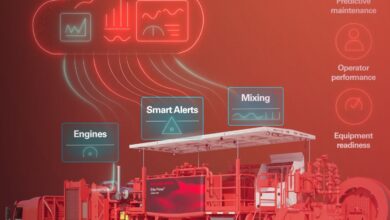Reservoir drives choice of RSS vs mud motors
Rotary steerables suit narrow formations; mud motors may be more cost-effective in broader boundaries
By Eric Malcore, Weatherford International Ltd
The ratio of directionally drilled wells to vertically placed wells is increasing. Access to progressively harder to reach reserves is driving more complex well geometries, which predicate the use of rotary steerable systems (RSS) to enhance rate of penetration (ROP), improve borehole quality and reduce torque and drag and stick slip. The various RSS technologies available today have revolutionized the drilling process in horizontal and deviated wells by facilitating greater intermediate reaches and longer laterals, allowing casing to be run more easily and allow proper weight transfer.
The service industry estimates that RSS technologies account for approximately $3.5 billion of the estimated $15 billion directional drilling market. The dynamics are shifting in favor of RSS.
Although not a new technology, high-performance mud motors also have become an accepted and reliable method in directional drilling operations, in many cases providing a cost-effective alternative to more costly rotary steerable tools.
Knowing when to choose a rotary steerable system and when to use a high-performance mud motor is critically important to optimize the drilling project from both an engineering performance and a cost perspective.
Many horizontal or deviated wells are extremely difficult or impossible to drill without an RSS. A key benefit of RSS technology is that it directs well trajectory without sliding, a condition that impacts the stability and orientation of the drill string to rotate in one direction. Without proper rotation, the entire drill string can stick to the borehole wall, making it difficult to achieve the desired weight transfer to the bit to achieve planned penetration rates. RSS tools provide continuous rotation of the drill pipe, minimizing the risk of the pipe becoming stuck or buckling.
Sliding also creates more waste because the lack of rotation keeps the fluid in a static state, making it more difficult to remove cuttings. The cuttings then pack off around the bottomhole assembly, causing the drill string to stick. With the continuous rotation enabled by rotary steerable tools, however, the friction holds the cuttings in suspension, allowing the fluid to create a vortex around the drill string to provide consistent hole-cleaning.
RSS technology also reduces drag, allowing extension in well reach, especially important in horizontal applications. Rotary steerables typically deliver a smooth in-gauge wellbore and control the toolface at the bit, which provides more accurate directional control and less tortuosity. They also enable the use of logging-while-drilling (LWD) azimuthal sensors to obtain full borehole images.
Applying Precise Directional Control
An important factor in rotary steerable systems is that they provide precise directional control and are therefore suited to narrow zones as tight as 1 ½ ft. In that regard, the tools also can provide geosteering in these narrow reservoirs, where corrections can be made in real time without sliding.
An RSS was used to successfully drill and complete a section of a horizontal water-injection well with an 8 ½-in. hole in Abu Dhabi.
Using Weatherford’s Revolution rotary steerable system, the operator was able to drill 2,200 ft (671 meters) at a depth of 8,725 to 12,918 ft (2,659 to 3,937 meters) in less than 90 hrs in one run, saving 41 hrs of drilling time and achieving a significant cost savings without nonproductive time.
The same system was used in another Abu Dhabi water-injection well to facilitate drilling and completion of an ultra-narrow, 6-ft zone with a 6-in. hole size and a run length of 4,193 ft (1,278 meters).
The operator was able to drill almost 20 ft (6 meters) deeper than anticipated, reaching a target that otherwise would have been missed.
In an onshore Saudi Arabian field prone to lost circulation, differential sticking and hydrogen-sulfide challenges, the same technology drilled a 3°/100-ft (30-meter) dogleg section with a 6 1/8-in. hole in an extended-reach horizontal water-injection well to a target depth of 16,856 ft (5,138 meters). Average ROP was 35 ft/hr (11 meters/hr). Prior to deployment of the system, optimal ROP had been difficult to achieve with a steerable motor assembly.
The system drilled a total of 7,316 ft (2,230 meters) in one run, achieving a field run-length record and meeting the operator’s goal to minimize excess tripping time. The operation saved 24 hours in drilling time and associated costs and allowed the operator to avoid stuck-pipe and lost-in-hole risks that occur in similar extended-reach wells.
In the Bay of Bengal in Eastern India, the same RSS technology performed a record-breaking shoe-to-shoe run in a claystone formation, with interbedded sandstone, marl and calcareous clay. The deep exploratory well had an inclination of 34°. The system drilled a 12 ¼-in. in-gauge hole and then drilled to a measured depth of 4,918 ft (1,499 meters) to improve the average ROP and reduce the number of wiper trips and backreaming. Drilling time was 192 hrs, with an average ROP of 25.6 ft/hr (7.8 meters/hr).
RSS technology has been enhanced in recent years by the development of motorized rotary steerable systems, where a power section placed on the RSS tool provides additional rpm and torque while still achieving the benefits of control and eliminated sliding. This hybrid-type application is increasingly being used in regions such as the Middle East, where the rock and carbonates are especially hard.

High-performance Alternative
Despite its many benefits, rotary steerable technologies can present some disadvantages, including cost, if used in situations where precise directional control is not the primary objective. For example, to justify the expense of using a rotary steerable system, the savings in rig time and other costs must be greater than the rotary steerable cost.
Rotary steerable drilling performance is delivered from the use of surface rotation, making them rig-dependent. They offer limited selection of bit sizes and speeds, and they involve greater complexities, both mechanically and electronically compared with motors. The high rotation speeds can cause premature wear to the casing and drill string, which can be slightly decoupled by using an integrated power section with the RSS, albeit adding significantly to the cost.
The replacement cost of a rotary steerable system, if it is lost in the hole, can exceed $1 million, depending on the system and size. That does not include the replacement cost of the accessory tools.
In cases where deploying an RSS is either cost-prohibitive or impractical, a high-performance mud motor can also achieve desired results, provided it is used in the proper application. However, high-performance mud motors are best suited to broad target areas and zones that require less precision, or in doglegs that are too aggressive for an RSS.
Used since the early 1990s for a multitude of oilfield applications, high-performance mud motors achieve greater torque and ROP than conventional mud motors. The mud motor leverages the reduced rubber profile in the power section to gain additional torque, which creates less deformation as the rotor spins. The reduced rubber deformation translates into more torque for the bit, which in turn allows for higher ROP and more aggressive bit designs.
For operators, the key advantage is that a high-performance mud motor can result in daily cost savings of 50% or more over an RSS. Lost-in-hole costs also are significantly lower; a 6 ¾-in. high-performance mud motor has a typical lost-in-hole cost of $168,000.
High-performance mud motors can often out-perform standard, non-motorized RSS, which depend on the rig rotary table to spin the bit. The motor power component of the high-performance mud motor, on the other hand, provides bit rotation and power directly to the bit. High-performance mud motors also can be used in situations that involve smaller rigs that can’t rotate fast enough to enable the rotary steerable mechanism to perform.
Another benefit is that all bit types and sizes can be used with a high-performance mud motor, making it useful for a variety of applications, including situations where a particular bit that is not compatible with an RSS must be run.
High-performance mud motors do, however, require sliding for directional control, which typically reduces ROP. They offer poor and inconsistent hole-cleaning and poor hole gauge. Also, LWD sensors often get pushed back farther from the bit. Motor bend with high-performance mud motors can limit the drill string rotary speed or not allow any rotation at all. These factors must be considered in selecting this method of drilling.

UAE Test Cases
High-performance mud motors have been used successfully in many deviated drilling operations and have achieved better-than-average ROP rates in three offshore test cases – the Thamama, Hith and Arab formations in the United Arab Emirates.
Seven wells in the Thamama Formation featured multiple target zones and were characterized by hard, Cretaceous limestone, but they presented no sliding issues. The operator used high-performance mud motors to drill the wells, which were not horizontal but had deviations ranging from 0° to 30° and had 8 ½-in. hole sizes.
The high-performance mud motors performed with an average ROP of 28 ft/hr (8.5 meters/hr). The best performance for the motors was 44 ft/hr (143.4 meters/hr), and the worst performance was 17 ft /hr (5.2 meters/hr). The Hith Formation also featured hard drilling conditions, with Jurassic anhydrite and dolomite rock but no sliding issues. The operator again drilled seven hole sections, all deviated but not horizontal, with 8 ½-in. hole sizes and a build section of 25° to 90°. In this case, the high-performance mud motors delivered an average ROP of 18 ft/hr (5.5 meters/hr). The highest ROP was 41 ft/hr (12.5 meters/hr), and the lowest was 9.88 ft/hr (3 meters/hr).
In the Arab Formation, featuring Jurassic carbonate/anhydrite rock, both sliding and directional control challenges were present. The lateral section was +/- 90°. Again, the operator drilled seven 8 ½-in. hole sections with high-performance mud motors.
The operation achieved an average ROP of 18 ft/hr (5.5 meters/hr). The best performance was 31 ft/hr (9.4 meters/hr), while the worst performance was 10 ft/hr (3 meters/hr).
Conclusion
The emergence of multiple technologies to optimize the drilling process can make selection of the proper technology confusing. Understanding reservoir properties along with diligent analysis of the well program, including formation, bit selection, directional program and other factors, must be considered when determining whether an RSS or a high-performance mud motor will achieve the best results in terms of cost and efficiency.
In tight or narrow formations where precise, directional control is needed, RSS are often the optimal choice for achieving drilling optimization and increased ROP. In zones with broader boundaries, a high-performance mud motor can provide results at a lower cost, provided issues such as sliding are carefully examined.
Revolution rotary steerable system is a trademark of Weatherford.




